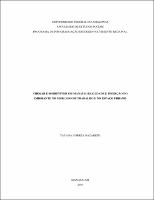| ???jsp.display-item.social.title??? |


|
Please use this identifier to cite or link to this item:
https://tede.ufam.edu.br/handle/tede/2488Full metadata record
| DC Field | Value | Language |
|---|---|---|
| dc.creator | Nazareth, Tayana Corrêa | - |
| dc.creator.Lattes | http://lattes.cnpq.br/9378372029003081 | por |
| dc.contributor.advisor1 | Teixeira, Pery | - |
| dc.contributor.advisor1Lattes | http://lattes.cnpq.br/7559505023134188 | por |
| dc.date.available | 2015-04-09 | - |
| dc.date.issued | 2010-12-22 | - |
| dc.identifier.citation | NAZARETH, Tayana Corrêa. Chegar e sobreviver em Manaus: realidade e inserção do imigrante no mercado de trabalho e no espaço urbano. 2010. 79 f. Dissertação (Mestrado em Desenvolvimento Regional) - Universidade Federal do Amazonas, Manaus, 2010. | por |
| dc.identifier.uri | http://tede.ufam.edu.br/handle/tede/2488 | - |
| dc.description.resumo | Um tema recorrente nos estudos de migração é dado pela inserção do migrante no local de destino, seja em termos espaciais, sociais ou ocupacionais. Esta dissertação propõe investigar e discutir a inserção do migrante no mercado de trabalho e no espaço urbano da cidade de Manaus durante a década de 1990. A análise foi feita mediante um conjunto de indicadores elaborados a partir dos dados censitários do Instituto Brasileiro de Geografia e Estatísticas (IBGE), disponíveis e organizados através do aplicativo livre REDATAM. Com base nos resultados obtidos, verificou-se uma maior inserção dos trabalhadores migrantes no mercado de trabalho da cidade, quando comparados aos não-migrantes. Percebe-se, porém, que esta maior inserção corresponde, em grande parte, ao mercado informal de trabalho, com desproteção social e excesso de horas de trabalho. Não obstante, este fenômeno varia segundo o tempo de residência do migrante, afetando principalmente os migrantes recentes, com menos de 3 anos de residência. Quanto ao desemprego, de maneira geral, revelou-se superior entre os não-migrantes, em termos de gênero, idade e escolaridade. Com efeito, entre os migrantes, a taxa de desemprego apresentou tendência declinante conforme aumentam os anos de residência no local de destino. O setor de serviços mostrou-se de grande destaque na absorção da força de trabalho, migrante e não-migrante, de Manaus, seguido pela indústria de transformação. A distribuição dos rendimentos por condição na unidade familiar mostra que mais da metade dos responsáveis, independentemente da condição migratória, recebe até 2 salários mínimos. No que se refere à inserção dos imigrantes no espaço urbano, a utilização e o processamento de mapas permitiu uma boa aproximação de sua distribuição na cidade. Assim, revelaram que a porção da zona leste da cidade é onde se localiza a maior parte dos migrantes recentes, fato que se mostra coerente com o maior crescimento populacional desta zona na década de 1990. | por |
| dc.description.abstract | A recurring theme in migration studies is given by the migrant's insertion at the destination, whether in spatial, social or occupational terms. This thesis proposes to investigate and discuss the migrant's integration into the labor market and in the urban space of the city of Manaus during the decade of 1990. The analysis was done by a set of indicators drawn from census data from the Brazilian Institute of Geography and Statistics (IBGE), available and organized through the free application REDATAM. Based on the results obtained, there was greater integration of migrant workers in the city's labor market when compared to non-migrants. It is clear, however, that this greater integration corresponds largely to the informal labor market, with social protection and excessive working hours. Nevertheless, this phenomenon varies according to the migrant's residence time, mainly affecting recent immigrants with less than three years of residence. As for unemployment, in general, proved to be higher than among non-migrants, in terms of gender, age and education. Indeed, among the migrants, the unemployment rate showed a declining trend as increase the years of residence at the destination. The services sector proved to be very prominent in the absorption of the labor force, migrant and non-migrant, Manaus, followed by the manufacturing industry. The distribution of income per condition in the family unit shows that more than half of those responsible, regardless of immigration status, receiving up to 2 minimum salaries. With regard to the integration of immigrants in urban areas, the use and processing of maps allowed a good approximation of their distribution in the city. Thus, they revealed that the portion of the east side of the city is where is the most recent migrants, a fact which appears consistent with the highest population growth in this area in the 1990s. | eng |
| dc.description.sponsorship | FAPEAM - Fundação de Amparo à Pesquisa do Estado do Amazonas | - |
| dc.format | application/pdf | por |
| dc.thumbnail.url | http://200.129.163.131:8080//retrieve/7055/Disserta%c3%a7%c3%a3o%20-%20Tayana%20Corr%c3%aaa%20Nazareth.pdf.jpg | * |
| dc.language | por | por |
| dc.publisher | Universidade Federal do Amazonas | por |
| dc.publisher.department | Faculdade de Estudos Sociais | por |
| dc.publisher.country | BR | por |
| dc.publisher.initials | UFAM | por |
| dc.publisher.program | Programa de Pós-Graduação em Desenvolvimento Regional | por |
| dc.rights | Acesso Aberto | por |
| dc.subject | Inserção do migrante - Espaço urbano - Manaus (AM) | por |
| dc.subject | Migrantes - Mercado de trabalho - Manaus (AM) | por |
| dc.subject | Migração - Manaus (AM) | por |
| dc.subject.cnpq | CIÊNCIAS SOCIAIS APLICADAS | por |
| dc.title | Chegar e sobreviver em Manaus: realidade e inserção do imigrante no mercado de trabalho e no espaço urbano | por |
| dc.type | Dissertação | por |
| Appears in Collections: | Mestrado em Desenvolvimento Regional | |
Files in This Item:
| File | Description | Size | Format | |
|---|---|---|---|---|
| Dissertação - Tayana Corrêa Nazareth.pdf | Dissertação - Tayana Corrêa Nazareth.pdf | 1.41 MB | Adobe PDF |  Download/Open Preview |
Items in DSpace are protected by copyright, with all rights reserved, unless otherwise indicated.




